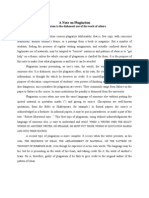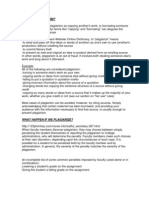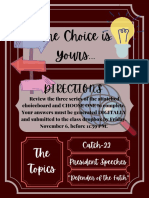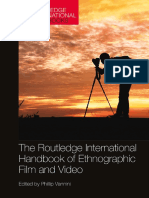0 ratings0% found this document useful (0 votes)
12 viewsTtu Plagiarism
Ttu Plagiarism
Uploaded by
zid3434This document discusses plagiarism and provides examples to identify plagiarism. It gives scenarios and determines whether each scenario constitutes plagiarism or not. The document aims to educate about properly attributing and citing sources to avoid plagiarism.
Copyright:
© All Rights Reserved
Available Formats
Download as PDF, TXT or read online from Scribd
Ttu Plagiarism
Ttu Plagiarism
Uploaded by
zid34340 ratings0% found this document useful (0 votes)
12 views22 pagesThis document discusses plagiarism and provides examples to identify plagiarism. It gives scenarios and determines whether each scenario constitutes plagiarism or not. The document aims to educate about properly attributing and citing sources to avoid plagiarism.
Original Title
ttu plagiarism
Copyright
© © All Rights Reserved
Available Formats
PDF, TXT or read online from Scribd
Share this document
Did you find this document useful?
Is this content inappropriate?
This document discusses plagiarism and provides examples to identify plagiarism. It gives scenarios and determines whether each scenario constitutes plagiarism or not. The document aims to educate about properly attributing and citing sources to avoid plagiarism.
Copyright:
© All Rights Reserved
Available Formats
Download as PDF, TXT or read online from Scribd
Download as pdf or txt
0 ratings0% found this document useful (0 votes)
12 views22 pagesTtu Plagiarism
Ttu Plagiarism
Uploaded by
zid3434This document discusses plagiarism and provides examples to identify plagiarism. It gives scenarios and determines whether each scenario constitutes plagiarism or not. The document aims to educate about properly attributing and citing sources to avoid plagiarism.
Copyright:
© All Rights Reserved
Available Formats
Download as PDF, TXT or read online from Scribd
Download as pdf or txt
You are on page 1of 22
Ministry of Higher Education and Scientific Research
University of Ain Temouchent BELHADJ Bouchaïb
Faculty of Letters, Languages, and Social Sciences
Department of Letters and English Language
Credit : 4 Coefficient : 2
Teaching Unit: Methodology
Academic year: 2022-2023
Plagiarism
Plagiarism
Plagiarize , UK usually plagiarise /ˈpleɪ.dʒ ə r.aɪz/ /-
dʒə.raɪz/ verb [ I or T ]
to use another person's idea or a part of their work and
pretend that it is your own .
Identifying Plagiarism: Practice
1. A student uses an internet article in
researching her paper. She finds several of
the ideas in the article useful, and develops
them in her own paper. Since she does not
quote from the text, she does not cite it in
her paper, but she does put the reference in
the bibliography.
Solution
1. This is plagiarism. Although the student was correct to
cite the article in her bibliography, this is not enough. If she
uses the ideas in her paper, she needs to acknowledge the
source of those ideas in the paper itself. One way to do this
is to acknowledge the source of the idea directly (i.e., “As
Jones has pointed out, . . . .”) Even with this reference, the
paper should also include a citation. Depending on your
discipline, this could be an in-text citation or a footnote or
endnote.
Identifying Plagiarism
2. In researching a paper on Mary Kingsley, a
student discovers that Kingsley was born in
Islington in 1862. She didn’t know this fact
previously. However, every article she reads
on Kingsley reports the same fact. She does
not acknowledge the source of this
information with a citation.
Solution
2- This is not plagiarism. Although the student
didn’t know this fact before, it is an easily
established fact that is well known to anyone
who has written on Kingsley. Since it is
undisputed and well known, it would fall into
the category of “common knowledge,” and does
not need to be cited.
Identifying Plagiarism
3. You are taking a class that a friend has
already taken. She lets you read her
paper in order to get some ideas, and tells
you to use any parts of the paper you find
useful. You incorporate some of her
paragraphs into your paper without
citation.
Solution
3- This is plagiarism. The fact that your friend
has given you permission to use her paper is not
relevant; if you are presenting work that
someone else has done as your own, it is still
plagiarism. Your friend would also be guilty of
violating the Honor Code by helping you to
plagiarize.
Identifying Plagiarism
4. A friend offers to let you read his paper in
order to get some ideas, and tells you to use
any parts of the paper you find useful. You
incorporate one of his paragraphs into your
paper, and you are careful to include all of
the citations from his paper in your footnotes,
so that the reader will be able to find the
original source of the information.
Solution
4- It is plagiarism. Even if you
include the citations, presenting
someone else’s work as your own is
plagiarism. Once again, your friend
would be also in violation of the
Honor Code.
Identifying Plagiarism
5. A student finds a picture on the web that
perfectly illustrates a point she wants to make
in her paper. She downloads the picture, but
does not use the website’s analysis; in
addition, she writes her own caption for the
picture. Since the analysis and caption are
her own, she does not include a citation for
the picture.
Solution
5- It depends. If the image is well-known (i.e., a picture of
the Mona Lisa), it can be considered common knowledge,
and therefore would not need a citation. However, if the
image is the product of another individual’s artistic or
intellectual work (i.e., a personal photograph, even of a
well-known artifact; or a graph or chart that forms part of
another person’s paper or research) it would be considered
plagiarism. In general, if the image represents the artistic or
intellectual work of another person, it should be cited.
Identifying Plagiarism
6. A student uses a data set collected by
his professor in his analysis of economic
trends. Since he develops his own
analysis, and since his professor has not
published the data, he does not include a
citation for the data set.
Solution
6- This is plagiarism. Even though the student did his
own analysis, the material he is working with was
generated by someone else, and that work should be
acknowledged. The fact that the data have not been
published is irrelevant; it is still someone else’s work, and
needs to be cited. Nor does it matter that the data set was
developed by the student’s professor; professional norms
require that all sources be acknowledged.
Identifying Plagiarism
7. You find an interesting analysis of Kant’s
categorical imperative in a book on 18th
century philosophers. You do not quote
directly from the text, but you mention the
author of the book as the source for this idea,
and include a citation at the end of the
paragraph.
Solution
7- This is the appropriate way to avoid
plagiarism. Even though you have not
quoted directly from the text, you should
mention the source of the idea in the body
of your paper, and cite the source. (qtd.in)
Identifying Plagiarism
8. A student finds some interesting
information on a website that is not under
copyright. She downloads several paragraphs
and incorporates them into her paper, but
doesn’t cite them, because they are in the
public domain.
Solution
This is plagiarism. It is irrelevant that the
material you are using is in the public
domain, or that it is not protected by
copyright. If it is not your work, you must
acknowledge its source.
Identifying Plagiarism
9. You are discussing your term paper with
your professor. She gives you an interesting
idea about how you might interpret some of
the material you have been studying. Since
the discussion was informal, and does not
pertain to an area in which your professor
intends you publish, you incorporate her
suggestions without attribution.
Solution
It is important to recognize the intellectual work of
others. Your professor’s ideas should be
acknowledged, even if she has not written on the
subject, and does not intend to do so. The same
would hold true if the idea came from a fellow
student or friend.
References:
APA Handbook
MLA Handbook
All pictures presented in this ppt are
from Google Images
You might also like
- Start Where You Are A Journal For Self Exploration PDFDocument1 pageStart Where You Are A Journal For Self Exploration PDFNyemwerai Muterere22% (9)
- Cel 2103 - Class Material Week 7 - Supporting DetailsDocument8 pagesCel 2103 - Class Material Week 7 - Supporting Detailsms zaza75% (4)
- Happy House 1 TBDocument110 pagesHappy House 1 TBAle Jazzsinel100% (1)
- Private Peaceful WorkbookDocument44 pagesPrivate Peaceful WorkbookJanet LNo ratings yet
- Atlas of The Ancient Near EastDocument337 pagesAtlas of The Ancient Near Eastfataliyev100% (19)
- Plagiarism ExercisesDocument4 pagesPlagiarism Exerciseshilma suryaniNo ratings yet
- A Note On PlagiarismDocument2 pagesA Note On Plagiarismzaruba78No ratings yet
- Week 5 ARAW1 Academic Integrity-MinDocument60 pagesWeek 5 ARAW1 Academic Integrity-MinunalkadirNo ratings yet
- ALS Policies and Procedures On Academic Integrity and Plagiarism 11-23-18 PDFDocument7 pagesALS Policies and Procedures On Academic Integrity and Plagiarism 11-23-18 PDFArtisticLawyerNo ratings yet
- CEL 2103 - CLASS MATERIAL WEEK 7 - SUPPORTING DETAILS - Teacher PDFDocument6 pagesCEL 2103 - CLASS MATERIAL WEEK 7 - SUPPORTING DETAILS - Teacher PDFSharip Maxwell100% (1)
- Using Case Studies To Identify Plagiarism: Task 1Document1 pageUsing Case Studies To Identify Plagiarism: Task 1Phan AnhNo ratings yet
- PlaigarismDocument2 pagesPlaigarismAshish RanjanNo ratings yet
- Ethics in Research: Ethical PrinciplesDocument20 pagesEthics in Research: Ethical PrinciplesJames Bryan M. PrimaNo ratings yet
- Plagiarism in Legal ResearchDocument6 pagesPlagiarism in Legal Researchmuwonge ukashaNo ratings yet
- Plagiarism - What It Is and How To Avoid ItDocument10 pagesPlagiarism - What It Is and How To Avoid ItSangram PandaNo ratings yet
- Avoiding PlagiarismDocument18 pagesAvoiding Plagiarismdongyun040911No ratings yet
- 5.Research Ethics PlagiarismDocument29 pages5.Research Ethics PlagiarismMihiret MekoneneNo ratings yet
- UntitledDocument3 pagesUntitledJohn Derek GrataNo ratings yet
- Book of PlagiarismDocument16 pagesBook of PlagiarismFaheem AslamNo ratings yet
- Plagiarism: DEMS First Year FOP 2023 Ms FrancisDocument26 pagesPlagiarism: DEMS First Year FOP 2023 Ms FrancisMediCube MedicubeNo ratings yet
- Plagiarism FinalDocument5 pagesPlagiarism Finalmhrafin04No ratings yet
- PlagiarismDocument1 pagePlagiarismJonna SalazarNo ratings yet
- Ethical Issues in Research WritingDocument4 pagesEthical Issues in Research WritingEditor IJTSRDNo ratings yet
- Essay On PlagiarismDocument5 pagesEssay On Plagiarismsohan hazraNo ratings yet
- 2.3 Plagiarism in AcademicsDocument2 pages2.3 Plagiarism in Academicssaumyaagarwal1202No ratings yet
- CEL2103 CLASS MATERIAL WEEK 7 - SUPPORTING DETAILS - StudentDocument8 pagesCEL2103 CLASS MATERIAL WEEK 7 - SUPPORTING DETAILS - StudentFikri MSuhaimiNo ratings yet
- Francisco PlagiarismDocument1 pageFrancisco PlagiarismeightNo ratings yet
- PlagiarismDocument22 pagesPlagiarismreshmaNo ratings yet
- Revised Discussion BoardDocument4 pagesRevised Discussion Boardapi-357986543No ratings yet
- Little Book of PlagiarismDocument10 pagesLittle Book of PlagiarismMai HeoNo ratings yet
- 3i-Module 4 Lesson 1Document21 pages3i-Module 4 Lesson 1colaNo ratings yet
- Back To School TipsDocument16 pagesBack To School TipsRejoice MpofuNo ratings yet
- Plagiarism PDFDocument6 pagesPlagiarism PDFحسنين غانم خضيرNo ratings yet
- 1 - What You Need To Know About PlagiarismDocument16 pages1 - What You Need To Know About PlagiarismRay GhosatyaNo ratings yet
- Research Ethics Assignment MamtaDocument4 pagesResearch Ethics Assignment MamtaMamta LuthraNo ratings yet
- Мистецтво англомовної письмовоDocument22 pagesМистецтво англомовної письмовоКатерина СанаєваNo ratings yet
- It Department: I.T. Social and Professional Issues 2Document12 pagesIt Department: I.T. Social and Professional Issues 2Mark Camo Delos SantosNo ratings yet
- English 13 Reflection PaperDocument2 pagesEnglish 13 Reflection PaperAnn Dominique CuisiaNo ratings yet
- Avoiding Plagiarism A Guide For StudentsDocument41 pagesAvoiding Plagiarism A Guide For StudentsHibri HalimNo ratings yet
- Plagiarism Ver 080510Document26 pagesPlagiarism Ver 080510rafid.abbasNo ratings yet
- Plagiarism (Purposive)Document26 pagesPlagiarism (Purposive)Hattie Rhonwen DeidreNo ratings yet
- Academic Honesty, Academic Dishonesty, and Plagiarism: What Liberty University Says About ItDocument23 pagesAcademic Honesty, Academic Dishonesty, and Plagiarism: What Liberty University Says About ItKaitlyn Reese100% (1)
- Tile: Plagiarism & How To Avoid It: Research MethodologyDocument3 pagesTile: Plagiarism & How To Avoid It: Research MethodologyEng-Mohammed Abu NuktaNo ratings yet
- Julienne Hanson, Ten Commandments (For Writing Academic Papers) - 1988Document3 pagesJulienne Hanson, Ten Commandments (For Writing Academic Papers) - 1988Rodrigo PereiraNo ratings yet
- English: Quarter 1 - Module 2Document14 pagesEnglish: Quarter 1 - Module 2Juan Carlo100% (1)
- Citing Sources EAPPDocument12 pagesCiting Sources EAPP4W1W1No ratings yet
- Potential Consequences For PlagiarizingDocument2 pagesPotential Consequences For PlagiarizingOluwatoyin EmiolaNo ratings yet
- Criminologist Licensure Examination ReviewDocument19 pagesCriminologist Licensure Examination ReviewSherwin Bryan MalabananNo ratings yet
- Super Heroes: A Modern Mythology Super Heroes: A Modern MythologyDocument2 pagesSuper Heroes: A Modern Mythology Super Heroes: A Modern MythologyCarolyn Faburada100% (1)
- Lesson4-Ethical Standards of ResearchDocument80 pagesLesson4-Ethical Standards of ResearchVincent francis DelacruzNo ratings yet
- Types of Plagiarism IDocument9 pagesTypes of Plagiarism IUdiana Puspa Dewi100% (1)
- Plagiarism Is A Serious Academic OffenceDocument4 pagesPlagiarism Is A Serious Academic OffenceMachel GiftNo ratings yet
- Group 2Document18 pagesGroup 2Pagatpatan James Allen QuibingcoNo ratings yet
- As1 Q3 English10 Verga FinalDocument8 pagesAs1 Q3 English10 Verga FinalMaureen AkimoriNo ratings yet
- Jamia Millia Islamia LEGAL METHOD 1Document13 pagesJamia Millia Islamia LEGAL METHOD 1arman.ali.c112No ratings yet
- Assignment On Plagiarism Business AdministrationDocument8 pagesAssignment On Plagiarism Business AdministrationAbdiel AbdullahNo ratings yet
- What Is Plagiarism in ResearchDocument5 pagesWhat Is Plagiarism in Researchprakash.omprakash.om1No ratings yet
- Academic IntegrityDocument4 pagesAcademic IntegrityrkageNo ratings yet
- What Is PlagiarismDocument3 pagesWhat Is Plagiarismhi2joeyNo ratings yet
- Lect7 ManageDocument35 pagesLect7 Manageatuhereza14No ratings yet
- Plagiarism - Types, Reasons, and ConsequencesDocument2 pagesPlagiarism - Types, Reasons, and ConsequencesImen AggouneNo ratings yet
- Handout 4 - Finding The Truth and PlagiarismDocument5 pagesHandout 4 - Finding The Truth and Plagiarismwokky77No ratings yet
- Lecture 4 Language Learning StrategiesDocument3 pagesLecture 4 Language Learning Strategieszid3434No ratings yet
- Lecture 3 LingDocument5 pagesLecture 3 Lingzid3434No ratings yet
- Lecture 2Document3 pagesLecture 2zid3434No ratings yet
- Lecture 5. 2023-1Document4 pagesLecture 5. 2023-1zid3434No ratings yet
- Lecture 1 LingDocument5 pagesLecture 1 Lingzid3434No ratings yet
- 2020 Book EducatingStudentsToImproveTheWDocument138 pages2020 Book EducatingStudentsToImproveTheWluznellir100% (1)
- The Kadambari of Bana - Mahashweta Vritanta - Karnik, GadgilDocument306 pagesThe Kadambari of Bana - Mahashweta Vritanta - Karnik, Gadgilsanskritsahitya71% (7)
- G6 Books ListDocument1 pageG6 Books ListAgrakshi MehtaNo ratings yet
- The Princess Bride Is A Multifaceted Story That Weaves Together Several Intriguing ThemesDocument1 pageThe Princess Bride Is A Multifaceted Story That Weaves Together Several Intriguing ThemesPragnya P. PadhiNo ratings yet
- Missing Three QuarterDocument12 pagesMissing Three QuarterTim BonineNo ratings yet
- Sample Thesis Statements For The Story of An HourDocument4 pagesSample Thesis Statements For The Story of An Houryolandajenkinsjackson100% (2)
- Drama TermsDocument35 pagesDrama TermsErin MartinNo ratings yet
- José Ortega y GassetDocument7 pagesJosé Ortega y GassetGiulia Galli Lavigne100% (1)
- English 10 Reflection 1Document4 pagesEnglish 10 Reflection 1api-552598567No ratings yet
- The Seven AgesDocument7 pagesThe Seven AgesGehad AminNo ratings yet
- FerdowsiDocument2 pagesFerdowsiCostales Fea Franzielle C.No ratings yet
- Edsc 330 Choice Board 2Document2 pagesEdsc 330 Choice Board 2api-526313353No ratings yet
- Reading Log EntriesDocument2 pagesReading Log Entriesfnarvaeza2009No ratings yet
- Novels, Short Stories, Poetry Feature Articles For MagazinesDocument9 pagesNovels, Short Stories, Poetry Feature Articles For Magazinesflm PedrofeNo ratings yet
- The Sun RisingDocument3 pagesThe Sun Risingbeadbeauty00No ratings yet
- The 5S's: Five Keys To A Total Quality Environment: by Takashi OsadaDocument5 pagesThe 5S's: Five Keys To A Total Quality Environment: by Takashi OsadaAvdhut GopewadNo ratings yet
- Heroes of Tara Demo Player's GuideDocument240 pagesHeroes of Tara Demo Player's GuideKody GrangerNo ratings yet
- The Routledge International Handbook of Ethnographic Film and Video-Routledge (2020)Document381 pagesThe Routledge International Handbook of Ethnographic Film and Video-Routledge (2020)Alex NakaókaNo ratings yet
- HanekeDocument25 pagesHanekemiroslavNo ratings yet
- Comic BookDocument17 pagesComic BookKimberly RaelNo ratings yet
- Module 4 Higher Education and Life AbroadDocument31 pagesModule 4 Higher Education and Life AbroadEmmanuel DalioanNo ratings yet
- Different Different: About Dad About DadDocument154 pagesDifferent Different: About Dad About DadRoland RüttenNo ratings yet
- Considering Kat1Document7 pagesConsidering Kat1Aaron PatunganNo ratings yet
- Fivecenturiesofe 00 StebuoftDocument448 pagesFivecenturiesofe 00 StebuoftMarla Do ValeNo ratings yet
- Bonta 1983Document4 pagesBonta 1983陈泊霖No ratings yet
- The - Hobbit.The - Desolation.of - Smaug.2013.720p.BluRay.x264. YTS - MX-English - SRTDocument117 pagesThe - Hobbit.The - Desolation.of - Smaug.2013.720p.BluRay.x264. YTS - MX-English - SRTMaani KhaanNo ratings yet






























































































